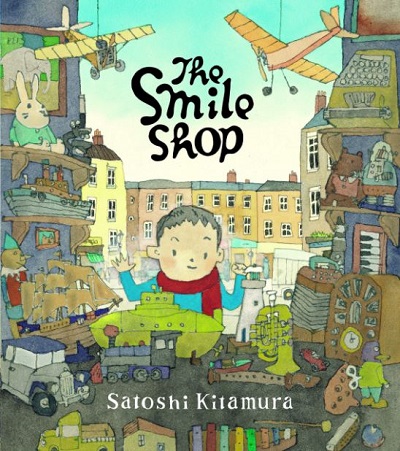
Price: £12.99
Publisher: Scallywag Press
Genre: Picture Book
Age Range: Under 5s Pre-School/Nursery/Infant
Length: 32pp
Buy the Book
The Smile Shop
Some of the best things in life cannot be bought or sold, and should be shared…
A little boy has saved all his pocket money for a special shopping trip and he’s very excited. Off to buy something for himself for the very first time, the boy goes to the market where he wanders round the stalls to discover what’s on offer. The apple pies look tasty, but the model boat is probably expensive. What about a hat? Or a book? The possibilities seem endless, and decisions difficult to make.
And then – disaster! A skateboarder crashes into the boy and almost all his money disappears into a drain. Only one coin is left, and it’s not enough to buy a single thing. Suddenly, before our eyes, the world is drained of colour – until the boy discovers a shop with photos on the wall. It’s called SMILE, so he goes in.
‘I have very little money,’ the boy says to the smartly-dressed man behind the counter. ‘Could I buy a smile, please? A little one, perhaps?’
But it seems that smiles cannot be bought or sold. They can be only be exchanged and shared – as the proprietor demonstrates, when he takes the boy’s photo and presents it to him, free of charge. And when you smile, of course, the whole world smiles along with you….
Full of urban conviviality and expressive observational detail, this gentle story offers a different perspective on the commercial messaging that children meet elsewhere. Satoshi Kitamura is a multi-award-winning artist whose books have been translated into many languages, and this is a quietly sophisticated offering with lots to admire and enjoy.
Text is largely confined to a single statement per spread and the story is told in the first person from the boy’s point of view, allowing plenty of room for observation, reflection and discussion. The boy’s voice can feel a little inconsistent, but Kitamura’s artwork creates a fully-rounded and highly expressive character that readers care about.
His deep blue sweater and dark red scarf are constant throughout, drawing the eye and enabling quick identification even on the busier spreads, but the colour saturation in his surroundings varies according to the boy’s mood and focus of attention. Look at the monochrome street following his accident, or the way the market stalls jump into focus as the boy looks and smells and gets involved. It’s details like these that direct and shape our experience of this lovely book, even though we may not be aware of them, and Kitamura works every spread to maximum effect.
The Smile Shop will be enjoyed by older readers as well as younger ones, and deserves to be widely shared – just like a smile!




